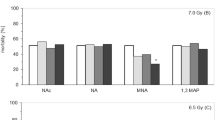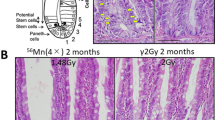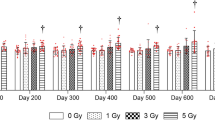Abstract
BACTERIAL endotoxins, zymosan and other complex polysaccharides are stimulants of the reticulo-endothelial system1,2. This follows from the enhanced phagocytic activity as measured by the rate of removal from the blood of intravenously injected carbon3. But these substances also have a radiation protective effect, as has been found with mice, rats and hamsters4. Therefore, it is accepted that this radiation protective effect is causally connected with the enhanced activity of the reticulo-endothelial system and that, in general, the radiation resistance of an organism with an augmented activity of the reticulo-endothelial system is greater than with a normal activity state of this unspecific defence system5. This concept is in agreement with the conjecture that the prime cause of death after whole-body X-irradiation depends primarily on the exhaustion of certain cells originating in the reticulo-endothelial system6.
This is a preview of subscription content, access via your institution
Access options
Subscribe to this journal
Receive 51 print issues and online access
$199.00 per year
only $3.90 per issue
Buy this article
- Purchase on Springer Link
- Instant access to full article PDF
Prices may be subject to local taxes which are calculated during checkout
Similar content being viewed by others
References
Biozzi, G., Benacerraf, B., and Halpern, B. N., Brit. J. Exp. Pathol., 36, 226 (1955). Riggi, S. J., and Di Luzio, N. R., Amer. J. Physiol., 200, 297 (1961). Benacerraf, B., Thorbecke, G. J., and Jacoby, D., Proc. Soc. Exp. Biol. Med., 64, 146 (1959).
Cooper, G. N., and Stuart, A. E., J. Pathol. Bact., 83, 227 (1962). Stuart, A. E., and Cooper, G. N., J. Path. Bact., 83, 245 (1962).
Biozzi, G., Benacerraf, B., Stiffel, C., and Halpern, B. N., C. R. Soc. Biol., 148, 431 (1954).
Smith, W. W., Alderman, I. M., and Gillespie, R. E., Amer. J. Physiol., 191, 124 (1957). Pillemer, L., Trans. N.Y. Acad. Sci., 17, 526 (1955). Balner, H., Old, L. J., and Clarke, D. A., Rad. Res., 15, 836 (1961). Mefferd, R. B., jun., Henkel, D. T., and Loefer, I. B., Proc. Soc. Exp. Biol. Med., 83, 54 (1953).
Taplin, G. V., Finnegan, C., Noyes, P., and Sprague, G., Amer. J. Roentgenol. Radium Ther. Nuclear Med., 71, 294 (1954). Zweifach, B. W., and Thomas, L., J. Exp. Med., 106, 385 (1957).
Paterson, E., Brit. J. Radiol., 30, 577 (1961).
Flemming, K., Naturwiss., 49, 87 (1962).
Stuart, A. E., Lancet, ii, 896 (1960); J. Path. Bact., 84, 193 (1962).
Stuart, A. E., Biozzi, G., Stiffel, C., Halpern, B. N., and Mouton, D., Brit. J. Exp. Path., 41, 599 (1960). Stuart, A. E., and Cooper, G. N., J. Exp. and Molecular Path. (in the press). Stuart, A. E., Nature, 196, 78 (1962).
Author information
Authors and Affiliations
Rights and permissions
About this article
Cite this article
FLEMMING, K. Radiation Protective Effect and Pharmacologically Changed Activity of the Reticulo-endothelial System. Nature 200, 1117–1118 (1963). https://doi.org/10.1038/2001117a0
Issue Date:
DOI: https://doi.org/10.1038/2001117a0
Comments
By submitting a comment you agree to abide by our Terms and Community Guidelines. If you find something abusive or that does not comply with our terms or guidelines please flag it as inappropriate.



